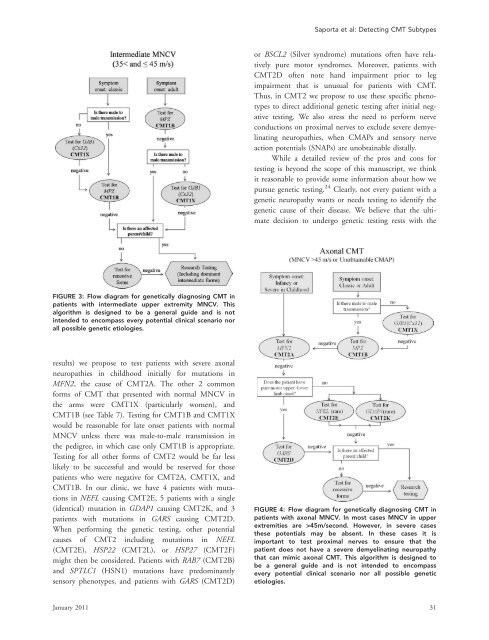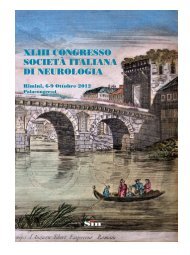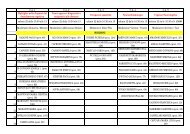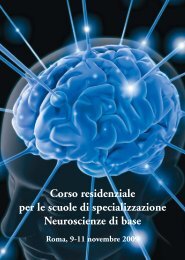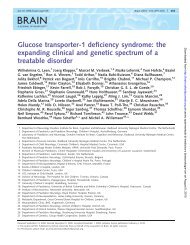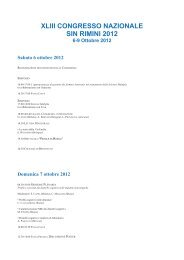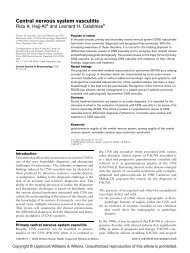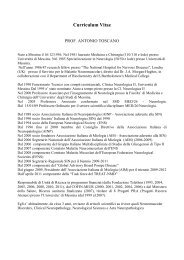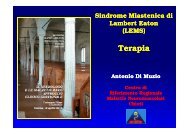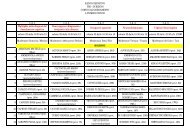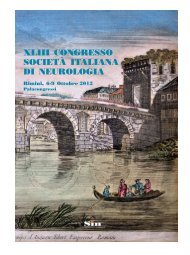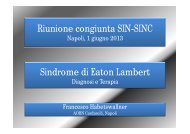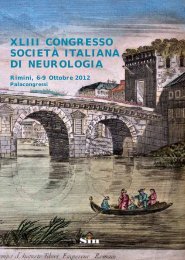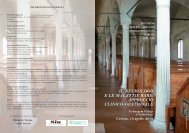Saporta et al: Detecting CMT Subtypesor BSCL2 (Silver syndrome) mutations often have relativelypure motor syndromes. Moreover, patients withCMT2D often note h<strong>and</strong> impairment prior to legimpairment that is unusual for patients with CMT.Thus, in CMT2 we propose to use these specific phenotypesto direct additional <strong>genetic</strong> testing after initial negativetesting. We also stress the need to perform nerveconductions on proximal nerves to exclude severe demyelinatingneuropathies, when CMAPs <strong>and</strong> sensory nerveaction potentials (SNAPs) are unobtainable distally.While a detailed review of the pros <strong>and</strong> cons fortesting is beyond the scope of this manuscript, we thinkit reasonable to provide some information about how wepursue <strong>genetic</strong> testing. 24 Clearly, not every patient with a<strong>genetic</strong> neuropathy wants or needs testing to identify the<strong>genetic</strong> cause of their <strong>disease</strong>. We believe that the ultimatedecision to undergo <strong>genetic</strong> testing rests with theFIGURE 3: Flow diagram for <strong>genetic</strong>ally diagnosing CMT inpatients with intermediate upper extremity MNCV. Thisalgorithm is designed to be a general guide <strong>and</strong> is notintended to encompass every potential clinical scenario norall possible <strong>genetic</strong> etiologies.results) we propose to test patients with severe axonalneuropathies in childhood initially for mutations inMFN2, the cause of CMT2A. The other 2 commonforms of CMT that presented with normal MNCV inthe arms were CMT1X (particularly women), <strong>and</strong>CMT1B (see Table 7). Testing for CMT1B <strong>and</strong> CMT1Xwould be reasonable for late onset patients with normalMNCV unless there was male-to-male transmission inthe pedigree, in which case only CMT1B is appropriate.Testing for all other forms of CMT2 would be far lesslikely to be successful <strong>and</strong> would be reserved for thosepatients who were negative for CMT2A, CMT1X, <strong>and</strong>CMT1B. In our clinic, we have 4 patients with mutationsin NEFL causing CMT2E, 5 patients with a single(identical) mutation in GDAP1 causing CMT2K, <strong>and</strong> 3patients with mutations in GARS causing CMT2D.When performing the <strong>genetic</strong> testing, other potentialcauses of CMT2 including mutations in NEFL(CMT2E), HSP22 (CMT2L), or HSP27 (CMT2F)might then be considered. Patients with RAB7 (CMT2B)<strong>and</strong> SPTLC1 (HSN1) mutations have predominantlysensory phenotypes, <strong>and</strong> patients with GARS (CMT2D)FIGURE 4: Flow diagram for <strong>genetic</strong>ally diagnosing CMT inpatients with axonal MNCV. In most cases MNCV in upperextremities are >45m/second. However, in severe casesthese potentials may be absent. In these cases it isimportant to test proximal nerves to ensure that thepatient does not have a severe demyelinating neuropathythat can mimic axonal CMT. This algorithm is designed tobe a general guide <strong>and</strong> is not intended to encompassevery potential clinical scenario nor all possible <strong>genetic</strong>etiologies.January 2011 31
ANNALS of Neurologypatient or the patient’s parents if a symptomatic child isunder 18 years of age. Reasons that patients give forobtaining testing include identifying the inheritance patternof their CMT, making family planning decisions,<strong>and</strong> obtaining knowledge about the cause <strong>and</strong> naturalhistory of their form of CMT. Natural history data isavailable for some forms of CMT such as CMT1A 14 <strong>and</strong>CMT1X, 15 which can provide guidance for prognosis,recognizing that there can be phenotypic variability inthese <strong>subtypes</strong>. Patients with other forms of CMT frequentlychoose to undergo <strong>genetic</strong> testing to contributeto the natural history data collection for other patientswith the same subtype. There are also reasons whypatients do not want <strong>genetic</strong> testing. These include thehigh costs of commercial testing <strong>and</strong> fears of discriminationin the workplace or in obtaining health insurance.Since there are currently no medications to reverse anyform of CMT, many patients decide against testing sincetheir therapies will not depend on the results. We maintainthat is always the patient’s decision whether or notto pursue <strong>genetic</strong> testing.Once a <strong>genetic</strong> diagnosis has been made in apatient, other family members usually do not need<strong>genetic</strong> testing but can be identified by clinical evaluationwith neurophysiology. We do not typically test patientsfor multiple <strong>genetic</strong> causes of CMT simultaneously,although we did identify 11 patients with multiple<strong>genetic</strong> causes of CMT. It is our current policy to onlyconsider <strong>genetic</strong> testing clinically affected family membersif their phenotype is atypical for the type of CMTin the family. In addition, we do not test asymptomaticminors with a family history of CMT, either by electrophysiologyor <strong>genetic</strong> testing, due to the chance forincreased psychological harm to the child. 25 We do routinelyperform limited nerve conduction studies, thoughnot needle electromyography (EMG), on symptomaticchildren with CMT. Since nerve conduction changes,including slowing, are often uniform <strong>and</strong> detectable inearly childhood in CMT, 17 testing of a single nerve is oftenadequate to guide <strong>genetic</strong> testing or determinewhether a symptomatic child is affected in a family withCMT.In summary, patients with inherited neuropathiescan serve as models of their own <strong>disease</strong> if their phenotypesare carefully analyzed <strong>and</strong> their genotypes characterized.Molecular mechanisms of demyelination, axonalloss <strong>and</strong> axoglial interactions can thus be investigated <strong>and</strong>rational therapies can be developed, not only for CMTbut for related neurodegenerative disorders. However,genotyping of families is essential for this approach, isconfusing to patients <strong>and</strong> physicians, <strong>and</strong> is very expensiveto undertake commercially or in research laboratories.We have developed what we believe is a focusedapproach to testing based on phenotype, physiology, <strong>and</strong>prevalence that we hope will prove useful in our clinic<strong>and</strong> to others who care for patients with inheritedneuropathies.AcknowledgmentsThis research was supported by grants from the MuscularDystrophy Association (M.E.S.), the NIH (NationalInstitutes of Neurological Disorders <strong>and</strong> Stroke <strong>and</strong>Office of Rare Diseases, U54NS065712 to M.E.S.), <strong>and</strong>the <strong>Charcot</strong> <strong>Marie</strong> <strong>Tooth</strong> Association (M.E.S.).We thank the patients <strong>and</strong> families that participatedin this study.Potential Conflicts of InterestDr Shy is on the Speakers Bureau of Athena DiagnosticLaboratories. There are no other disclosures for any author.References1. <strong>Charcot</strong> J, <strong>Marie</strong> P. [On a particular form of progressive muscularatrophy, often familial, commencing with the feet <strong>and</strong> the legs<strong>and</strong> later reaching the h<strong>and</strong>s.] Sur une forme particulaire d’atrophiemusculaire progressive souvent familial debutant par lespieds et les jamber et atteingnant plus tard les mains. Revue deMédecine 1886;6:97–138. [French]2. <strong>Tooth</strong> H. The peroneal type of progressive muscular atrophy. London:Lewis, 1886.3. Skre H. Genetic <strong>and</strong> clinical aspects of <strong>Charcot</strong>-<strong>Marie</strong>-<strong>Tooth</strong>’s <strong>disease</strong>.Clin Genet 1974;6:98–118.4. Harding AE, Thomas PK. The clinical features of hereditary motor<strong>and</strong> sensory neuropathy types I <strong>and</strong> II. Brain 1980;103:259–280.5. Harding AE, Thomas PK. Genetic aspects of hereditary motor <strong>and</strong>sensory neuropathy (types I <strong>and</strong> II). J Med Genet 1980;17:329–336.6. Shy M, Lupski JR, Chance PF, et al. The hereditary motor <strong>and</strong> sensoryneuropathies: an overview of the clinical, <strong>genetic</strong>, electrophysiologic<strong>and</strong> pathologic features. In: Dyck PJ, Thomas PK, eds.Peripheral neuropathy. Vol. 2. 4th ed. Philadelphia: WB Saunders,2005:1623–1658.7. Engl<strong>and</strong> JD, Gronseth GS, Franklin G, et al. Practice parameter:evaluation of distal symmetric polyneuropathy: role of autonomictesting, nerve biopsy, <strong>and</strong> skin biopsy (an evidence-based review).Report of the American Academy of Neurology, American Associationof Neuromuscular <strong>and</strong> Electrodiagnostic Medicine, <strong>and</strong>American Academy of Physical Medicine <strong>and</strong> Rehabilitation. Neurology2009;72:177–184.8. Engl<strong>and</strong> JD, Gronseth GS, Franklin G, et al. Practice parameter:evaluation of distal symmetric polyneuropathy: role of laboratory<strong>and</strong> <strong>genetic</strong> testing (an evidence-based review). Report of theAmerican Academy of Neurology, American Association of Neuromuscular<strong>and</strong> Electrodiagnostic Medicine, <strong>and</strong> American Academyof Physical Medicine <strong>and</strong> Rehabilitation. Neurology 2009;72:185–192.9. Verhoeven K, Claeys KG, Zuchner S, et al. MFN2 mutation distribution<strong>and</strong> genotype/phenotype correlation in <strong>Charcot</strong>-<strong>Marie</strong>-<strong>Tooth</strong> type 2. Brain 2006;129:2093–2102.32 Volume 69, No. 1


